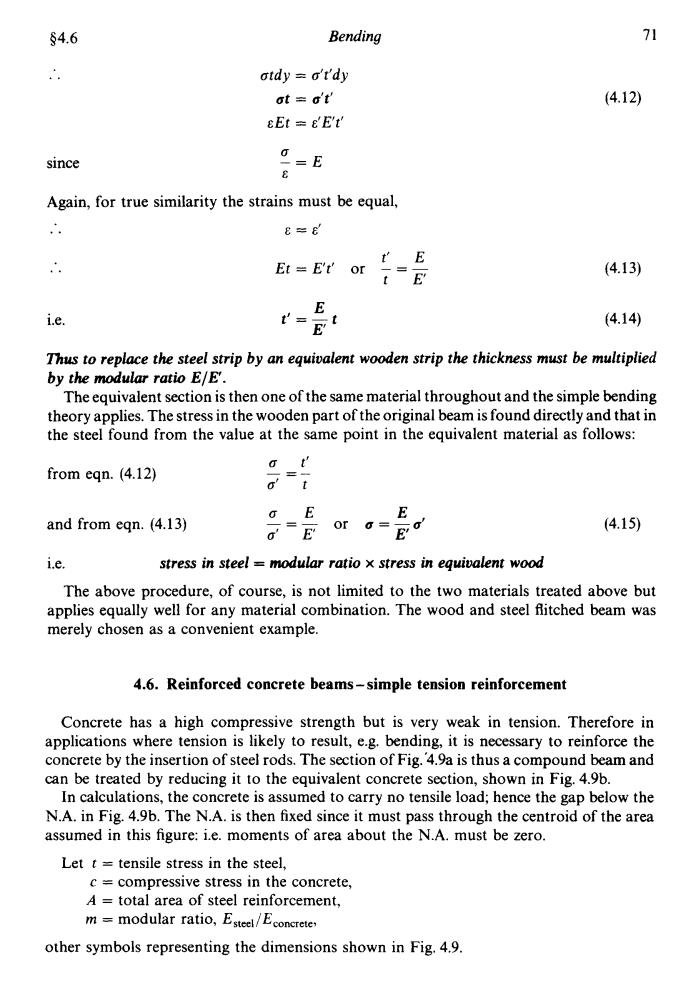正在加载图片...

§4.6 Bending 71 otdy o't'dy ot a't' (4.12) &Et =&'E't' since a=E Again,for true similarity the strains must be equal, 8=8 t'E Et =E't'or (4.13) t E' i.e. t-Et (4.14) Thus to replace the steel strip by an equivalent wooden strip the thickness must be multiplied by the modular ratio E/E'. The equivalent section is then one of the same material throughout and the simple bending theory applies.The stress in the wooden part of the original beam is found directly and that in the steel found from the value at the same point in the equivalent material as follows: ot' from eqn.(4.12) σE and from egn.(4.13) -E or a- (4.15) i.e. stress in steel modular ratio x stress in equivalent wood The above procedure,of course,is not limited to the two materials treated above but applies equally well for any material combination.The wood and steel flitched beam was merely chosen as a convenient example. 4.6.Reinforced concrete beams-simple tension reinforcement Concrete has a high compressive strength but is very weak in tension.Therefore in applications where tension is likely to result,e.g.bending,it is necessary to reinforce the concrete by the insertion of steel rods.The section of Fig.4.9a is thus a compound beam and can be treated by reducing it to the equivalent concrete section,shown in Fig.4.9b. In calculations,the concrete is assumed to carry no tensile load;hence the gap below the N.A.in Fig.4.9b.The N.A.is then fixed since it must pass through the centroid of the area assumed in this figure:i.e.moments of area about the N.A.must be zero. Let t=tensile stress in the steel, c compressive stress in the concrete, A total area of steel reinforcement, m=modular ratio,Esteel/Econcrete other symbols representing the dimensions shown in Fig.4.9.54.6 Bending .. since atdy = a’t’dy at = a’t’ &Et = &‘Et’ a -=E & Again, for true similarity the strains must be equal, .. E = E’ i.e. E E t‘=-t 71 (4.12) (4.13) (4.14) Thus to replace the steel strip by an equivalent wooden strip the thickness must be multiplied by the modular ratio EIE. The equivalent section is then one of the same material throughout and the simple bending theory applies. The stress in the wooden part of the original beam is found directly and that in the steel found from the value at the same point in the equivalent material as follows: a t’ a’ t from eqn. (4.12) - - -- and from eqn. (4.13) aE E a‘ E E --- - or a=--6‘ (4.15) i.e. stress in steel = modular ratio x stress in equivalent wood The above procedure, of course, is not limited to the two materials treated above but applies equally well for any material combination. The wood and steel flitched beam was merely chosen as a convenient example. 4.6. Reinforced concrete beams - simple tension reinforcement Concrete has a high compressive strength but is very weak in tension. Therefore in applications where tension is likely to result, e.g. bending, it is necessary to reinforce the concrete by the insertion of steel rods. The section of Fig.’4.9a is thus a compound beam and can be treated by reducing it to the equivalent concrete section, shown in Fig. 4.9b. In calculations, the concrete is assumed to carry no tensile load; hence the gap below the N.A. in Fig. 4.9b. The N.A. is then fixed since it must pass through the centroid of the area assumed in this figure: i.e. moments of area about the N.A. must be zero. Let t = tensile stress in the steel, c = compressive stress in the concrete, A = total area of steel reinforcement, rn = modular ratio, Esteel/Econcrete, other symbols representing the dimensions shown in Fig. 4.9